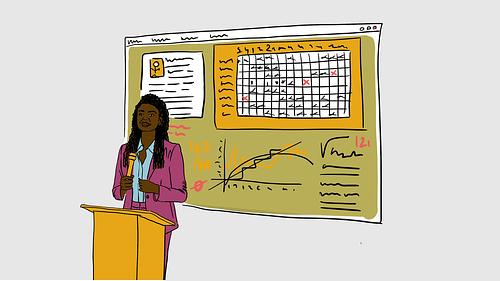
Context and learning objectives
Financing needs are considerable in order to achieve the Sustainable Development Goals by 2030. Regarding SDG 7, World Bank estimates show that nearly USD 20 billion are needed for universal electrification in Sub-Saharan Africa, with around USD 10 billion per year for West and Central Africa.
However, since the COVID-19 pandemic, resources have become more limited and the order of priorities may change.
To successfully implement energy access programmes, it is therefore important, on the one hand, to make good use of available funds, and on the other hand, to be well aware of the financing options available.
The objective of this training is to provide participants with tools to familiarise themselves with economic and financial parameters and indicators, to learn how to break down a project into different costs (internal, external, and risk provisions), to analyse a financial offer, and to understand the various challenges of the financial environment as well as the different sources of financing.
Before studying the various solutions for access to electricity and the needs they meet, let us share a common preliminary vision by asking the question : "when and on what criteria can we consider that we have "access to electricity"? This is the purpose of this first module.
The various categories of electricity consumers (current and future) have different expectations in terms of the services provided by an electrification infrastructure, and have very heterogeneous payment capacities, or even none at all. Let's see who these consumers are, and what solutions can meet their needs.
The economic relevance of an electricity access project depends on many parameters; one of the most influential is the amount of electricity that needs to be produced to meet the needs of the people and businesses involved.
This module introduces the overall approach to electricity demand assessment, which is one of the feasibility studies required before defining the technical solution to be deployed. There are several ways to conduct such an assessment: this module describes the broad outlines of the methodology to be followed, and it highlights recurrent issues that need to be addressed.
What solution should be proposed to meet the needs expressed by households, entrepreneurs and community services in the area targeted by the rural electrification project? Should a small grid be deployed and if so how should it be supplied with electricity? Should a stand-alone systems distribution network be set up ? Or should we rely on kiosks where people can buy services?
In this module, we will see how the project owner can choose the relevant rural electrification solutions with regards to the characteristics of the area targeted by its project. Four steps should be followed:
1. Assess locally available energy resources;
2. Geospatial consumers assessment;
3. Sizing production and storage facilities;
4. In the case of a small grid: choose the configuration of the production/storage/distribution system.
EPC, WCR, CAPEX or OPEX... These concepts are simpler than you might think, but they are essential for managing an electricity access project. Discover or revisit them in this module.
This course only deals with economic and financial concepts, not with legal and regulatory ones: the various ownership and facility management models will be covered in the "Policy and Governance" course.
The NPV, IRR, and LCOE... Go into the details of these indicators by calculating them yourself! But first, let's recall them.
A project sensitivity analysis is a financial modelling tool used to predict the impact of different variables on project outcomes. This analysis helps to understand how changes in key assumptions (these variables were covered in Module 5) such as the volume of energy sold, costs, price per kWh and other financial measures, affect the profitability and overall financial health of a project. This exercise helps to identify the risks that a project may face if there is a change in the environment that the project was designed and built in.
Validation of this module with a view to certification is not conditional on completing a Quiz, but only on completing the various applications on offer.
After a project leader has prepared a project of decentralised access to electricity that seems viable, based on a business model that quantifies its economic interest, it will have to find the necessary funding.
Understand green finance and how it aims to meet the needs of electricity access stakeholders. Electricity is a basic resource that African countries do not have full access, while the potential of sustainable energy projects for electrification remains under-exploited.
- Be familiar with the key carbon footprint concepts, as well as the main international standards and reporting frameworks,
- Understand the carbon footprint of organisations and products, as well as key data, tools and resources,
- Know how to calculate a simple carbon footprint, discover the results of case studies and discuss how to reduce your carbon footprint.
To convince investors and creditors to support the project, the project owner must prepare two very distinct documents: the business model and the business plan.
At the end of this module, you will know what characterises these two documents and what differentiates them.
Target audience
- Rural electrification managers (general directors, financial directors, engineers, technical partners, funders, etc.)
- Engineer and rural electrification project manager
- Technical and financial partners in the field
- Students and researchers
Format
This training is delivered online, offering learners complete flexibility through unlimited access to content, available 24/7 on the IHEDD distance learning platform. Each participant can progress at their own speed, depending on their availability.
To encourage exchange and mutual support, a forum is available in the training space, complemented by a WhatsApp group to create a community of learners.
In addition, regular virtual meetings (online classes) are organised with trainers and the learner community. These sessions allow participants to go further into the concepts covered, discuss challenges encountered, and obtain answers to questions.
Acknowledgement
This course is supported by the UK Aid from the UK government via Transforming Energy Access platform. However, the views expressed are those of the presenters and do not necessarily represent the official views of UK government.
Modalities
Cette formation est dispensée en ligne, offrant aux apprenant·es une flexibilité totale grâce à un accès illimité aux contenus, disponibles 24h/24 et 7j/7 sur la plateforme d’enseignement à distance de l’IHEDD. Chaque participant·e peut ainsi avancer à son propre rythme, selon ses disponibilités.
Pour favoriser l’échange et l’entraide, un forum est mis à disposition sur l’espace de formation, complété par un groupe WhatsApp permettant de créer une communauté d’apprenants.
En complément, des rendez-vous réguliers en visioconférence (classe virtuelle) sont organisés avec les formateur·rices et la communauté d’apprenant·es. Ces sessions permettent d’approfondir les notions abordées, d’échanger sur les problématiques rencontrées et d’obtenir des réponses aux questions.
Validation of acquired knowledge
At the end of the course, IHEDD will award a certificate on behalf of Ferdi, a recognised professional training organisation. This certificate states the name of the course and the total number of validated training hours. To receive it, participants must pass a final quiz with a minimum score of 60%.
History of previous sessions
2–30 June 2025 | Number of participants: 26 | Success rate: 31%
Practical information
- Next session: January 05, 2026 > February 02, 2026
- Registration deadline: December 15, 2025
- Payment deadline: February 02, 2026
- Duration: 12 hours 45 minutes of estimated self-study on the modules + 6 hours of virtual classes
- The training is delivered in English
- Equipment: It is essential to have a computer and an internet connection.
- The training is accessible to people with disabilities.
- Prerequisites: No previous academic qualifications needed
- Capacity: 40
Participation in training costs
Total or partial scholarships are offered through partner contributions (Transforming Energy Access) with the goal of fostering a diverse cohort of participants, encompassing various sectors (public and private), geographic backgrounds, and genders.
Training supervisors
- Jérémy GALLETProject Manager EDF, Administrator Électriciens sans frontière

- Ismaël NACOULMAFormer Managing director at ABER (Agence Burkinabé de l’Électrification Rurale)

Trainers
- Ismaël NACOULMAFormer Managing director at ABER (Agence Burkinabé de l’Électrification Rurale)







